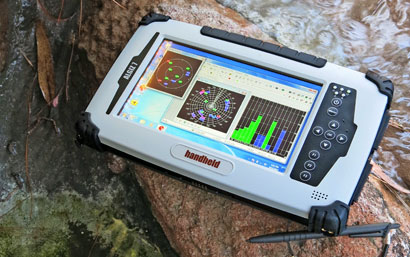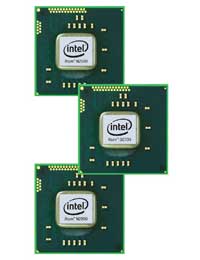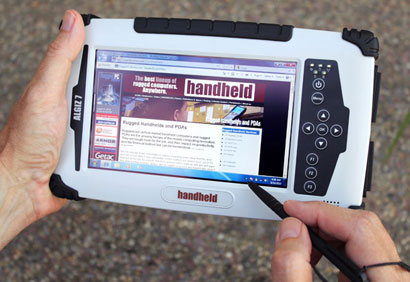|
Handheld Algiz 7
Handheld's popular ultra-rugged Algiz 7 Windows tablet gets a thorough tech update, and lots more performance
(by Conrad H. Blickenstorfer -- see full review of original Algiz 7)
On August 27, 2013, the Handheld Group announced a technology update to their Algiz 7 rugged tablet computer. Handheld replaced the single-core Intel Atom Z530 of the original Algiz 7 with the much newer dual-core Atom N2600, changed the integrated GPS for better field performance, enhanced data security, doubled the size of both RAM and onboard storage, upgraded the camera, added antenna diversity, and made Gobi 3000 available. The Algiz 7 tablet still looks the same, but it's now a much more powerful device, and I'll discuss what it all means to customers.

For those not familiar with the product, here's an overview. The Algiz 7 platform was originally introduced February 2010 as an ultra-rugged small Windows tablet solution for applications that require computing gear certified to MIL-STD-810G. As such, it joined the Handheld Group's strikingly designed lineup of Algiz tablets and Nautiz handhelds which the Sweden-based company sells and supports worldwide through its network of subsidiaries and distributors. The tablet has a 7-inch resistive touch screen with 17:10 aspect ratio 1024 x 600 pixel WSVGA resolution. It measures 9.1 x 5.5 x 1.6 inches and weighs 2.4 pounds. Among the tablet's many commendable features are a bright display that works well outdoors, very good connectivity, and hot-swappable power via dual external battery packs. We examined the original Algiz 7 in detail, and presented the results in our computer may want to read our August 2010 full review of the Handheld Algiz 7.
At the time, we liked the handy, attractive tablet, but wished for a bit more speed, better graphics, the ability to play HD video, better marked ports, a dual input digitizer option, and a wider vertical viewing angle. Our concerns were minor, though, and according to Handheld, the Algiz 7 turned out to become one of its most popular products. It's 3-1/2 years later, and Handheld introduced an updated version of the Algiz 7. What was addressed, and what wasn't?
So what's new?
Here is what Handheld changed in the new 2013 version of the Algiz 7 tablet:
- CPU — The old single-core Atom Z530 has been replaced with a dual-core Atom N2600 for higher performance and faster graphics.
- Storage — The 128GB SSD is twice the size of the original, and it uses the much faster SATA interface instead of PATA.
- RAM — RAM memory has doubled to 4GB of faster DDR3. More RAM is always good, and DDR3 is more power-efficient.
- Camera — The camera is now 5mp instead of just 2mp, and it's much improved.
- WLAN — WiFi is faster (802.11b/g/n instead of just 802.11b/g), Bluetooth is version 4.0 (instead of 2.0)
- WWAN — There's now optional Gobi 3000 instead of Gobi 2000. Gobi 3000 doubles the HSPA downlink speed.
- Security — There's a TPM (Trusted Platform Module) module for data security.
After the updated Algiz XRW and the new Algiz 10X, the Algiz 7 is the third Handheld product using the Intel Atom N2600 processor, so here are a few words about the chip. The N2600 is not a successor to the Z530 "Silverthorne" processor used in the original Algiz 7. Instead, it's a third generation descendent (codenamed "Cedarview") of the Atom N270 that powered tens of millions of netbooks.
 Codenamed "Cedarview," the N2600/N2800 was the first Atom family to use 32nm process technology instead of the older 45nm, making for smaller, more efficient packages. Cedarview processors are dual-core systems whereas before only desktop-oriented Atom versions had two cores. Graphics performance benefits from a different design and much faster clock speed, resulting in Intel claims of 2X graphics performance compared to the second generation Atoms. And integrated hardware-accelerated video decoding enables smooth full HD (up to 1080p) video playback, something that was not possible with earlier Atom chips. Codenamed "Cedarview," the N2600/N2800 was the first Atom family to use 32nm process technology instead of the older 45nm, making for smaller, more efficient packages. Cedarview processors are dual-core systems whereas before only desktop-oriented Atom versions had two cores. Graphics performance benefits from a different design and much faster clock speed, resulting in Intel claims of 2X graphics performance compared to the second generation Atoms. And integrated hardware-accelerated video decoding enables smooth full HD (up to 1080p) video playback, something that was not possible with earlier Atom chips.
Thanks to the 32nm process technology and additional power conservation measures, the N2600 has a maximum thermal design power of just 3.5 watts, considerably less than the 5.5 watts of the second-gen N450. The NM10 Express chipset is miserly as well, with a TDP of just 2.1 watts, making for a combined CPU/chipset maximum draw of just 5.6 watts.
After initially guesstimating the performance of the upgraded Algiz 7, we had a chance to benchmark a production version in September 2013. The tablet below shows the benchmark performance of the new version of the Handheld Algiz 7 compared to the original.
|
Handheld Algiz 7 Benchmarks New vs. Old (PassMark 6.1, 32-bit version)
|
|
PERFORMANCE COMPARISON
|
Algiz 7 2013
|
Algiz 7 original
|
|
Processor Type:
|
Intel Atom
|
Intel Atom
|
|
Processor Model
|
N2600 dual-core
|
Z530 single-core
|
|
CPU Speed
|
1.60GHz
|
1.60GHz
|
|
Thermal Design Power (TDP)
|
3.5 watts
|
2.3 watts
|
|
Disk
|
128GB SATA SSD
|
64GB PATA SSD
|
|
BatteryMon min draw
|
8.3 watts
|
8.5 watts
|
|
CPU Mark
|
461.8
|
217.8
|
|
2D Graphics Mark
|
NA
|
56.7
|
|
Memory Mark
|
217.6
|
208.7
|
|
Disk Mark
|
1,654.5
|
175.6
|
|
3D Graphics Mark
|
64.9
|
17.7
|
|
Overall PassMark
|
502.5
|
141.6
|
|
ALU
|
10,528
|
5,050
|
|
FPU
|
7,681
|
3,629
|
|
MEM
|
7,274
|
4,143
|
|
HDD
|
26,860
|
6,804
|
|
GDI
|
1,451
|
1,866
|
|
D2D
|
798
|
976
|
|
OGL
|
7,404
|
326
|
|
Overall CrystalMark
|
61,996
|
22,794
|
Quite obviously, the new Handheld Algiz 7 offers a very substantial performance boost compared to the original version. Note the radically higher Disk Mark and HDD performance. We had expected much faster disk performance in the new unit due to the switch from PATA (Parallel Advanced Technology Attachment) to the much faster SATA serial version. While SATA SSD performance greatly varies with the particular type and brand of SSD, Handheld certainly found a very speedy one.
Overall, we saw an astonishing 3.55X benchmark improvement in the PassMark suite, and an equally substantial 2.72X improvement in the CrystalMark suite. That is a very noticeable difference.
Power draw was essentially unchanged from the original unit; decent, but not quite as good as we expected. oFr anticipated field use, we'd recommend the optional dual 38.5 watt-hour batteries.

The case for the new Algiz 7
What's the business case for a small conventional rugged tablet computer with a resistive touch screen? There are challenges and there are opportunities. The tablet market is booming and the tablet form factor is now almost universally accepted, but virtually all of those hundreds of millions of tablets are sleek, lightweight consumer models running either iOS or Android, and they all use capacitive multi-touch. The Algiz 7, on the other hand, is a legacy tablet workhorse that runs Windows 7 and even has a serial port.
In a vehicle analogy, the Algiz 7 is a true offroader ready for work, compared to the slim, glitzy media tablets that'd be light SUV crossovers with smartphone hook-ups and many cupholders. The Algiz 7 is a tough tool for outdoor jobs, one that lasts, has a long life cycle and industry expert support (with a price to match, of course). And the new version now offers performance on par with that of high-end Intel Core 2 Duo devices of not so long ago.
Most improvements, though, are on the electronics side. We would have liked to see an update to the somewhat arbitrarily laid-out hardware buttons, labels on the still hard-to-operate protective port plugs, an active digitizer or capacitive touch option, and a larger vertical viewing angle.
Summary
The Algiz 7 is an ultra-rugged Windows-based tablet computer. Its compact size and low 2.4 pound weight make it a versatile and highly functional tablet solution in numerous field deployments where larger, heavier tablets aren't practical and consumer tablets simply not sturdy and durable enough.
Technology updates to the Algiz 7 Summer 2013 include a switch to the significantly more powerful dual-core Atom N2600 processor, twice the (faster DDR3) RAM and twice the disk space, and TPM for data security.
With these updates, the tablet now offers very good computing power in this class (expect a 3x improvement over the original model), without compromising battery life. The 7-inch daylight-viewable wide-format resistive touch display with its 1024 x 600 pixel resolution is bright and responsive.
Like all Handheld products, the Algiz 7 tablet is rugged enough to be used in almost any environment, and its integrated bumpers protect against dents and scratches.
Compared to mass market media tablets, the price is high, but in terms of functionality for the jobs the Algiz 7 is intended for, it is well justified.
Overall, the substantially upgraded electronics in this latest version of the Handheld Algiz 7 rugged Windows tablet provide the performance and functionality needed for virtually any job out there in the field.
See the Algiz 7 page at Handheld website.
|
|
 Specifications Handheld Algiz 7
Specifications Handheld Algiz 7
|
|
Status
|
02/2010, upated 05/2013, 09/2013, 06/2016
|
|
Type
|
Ultra-rugged Tablet PC
|
|
OS
|
Windows 7 Ultimate
|
|
Processor
|
Dual-core Intel Atom N2600, 1MB L2 cache
|
|
CPU Speed
|
1.60GHz
|
|
Chipset
|
Intel NM10
|
|
Standard/Max RAM
|
4GB DDR3 RAM
|
|
Disk/drive
|
128GB SATA/600 solid state drive (SSD)
|
|
Optical drive
|
Optional external
|
|
Card slots
|
1 x microSDXC, 1 x SIM, 1-3 free internal Mini-PCIe (depending on configuration)
|
|
Display type
|
"MaxView" sunlight-readable TFT
|
|
Display size/res
|
7" SVGA (1024 x 600 pixel)
|
|
Digitizer/pens
|
Resistive touchscreen
|
|
Keyboard/scale
|
10 keys, onscreen + optional external
|
|
Housing
|
Unknown, protective rubber bumpers
|
|
Operating Temp
|
-27.4° to 145.4°F (-33° to 63°C)
|
|
Sealing
|
IP65, MIL-STD-810G
|
|
Shock
|
26 4-feet drops to concrete per MIL-STD-810G Method 516.5, Procedure IV
|
|
Vibration
|
MIL-STD-810G, Method 514.6 Procedures I & II, General minimum integrity and the more rigorous loose cargo test
|
|
Altitude
|
15.000 ft at 73°F
|
|
Size (WxHxD)
|
9.1 x 5.5 x 1.6 inches (242 x 144 x 40mm)
|
|
Weight
|
2.4 pounds (1.1 kg)
|
|
Power
|
Hot-swappable dual Li-Polymer battery packs, 7.4V, 2,600mAh, 19.24 watt-hours each; optional dual 38.5 watt-hour packs
|
|
Camera
|
5mp camera with LED illuminator
|
|
Interface
|
2 x USB 2.0, 1 x DB9 RS232, 1 x RJ45, audio in/out, docking connector, 1 speaker
|
|
Wireless
|
802.11b/g/n, Bluetooth v4.0, integrated u-blox GPS, optional WWAN Gobi 3000 (HSPA+, GSM/GPRS/EDGE, CDMA EVDO Rev. A)
|
|
List price
|
inquire
|
|
Contact
|
www.handheldgroup.com
|
|
Brochure
|
 Algiz 7 Algiz 7
|
|

|
 Contact
Contact
|
Handheld Group
Kinnegatan 17 A
S-531 33 Lidköping
SWEDEN
Web: www.handheldgroup.com
HHCS Handheld USA Inc.
456 SW Monroe Avenue, Suite 106
Corvallis, OR 97333, USA
Tel: (541) 752-0313
Fax: (541) 752-0338
Web: www.handheld-us.com
Email: info @ handheld-us.com
|
|





 Codenamed "Cedarview," the N2600/N2800 was the first Atom family to use 32nm process technology instead of the older 45nm, making for smaller, more efficient packages. Cedarview processors are dual-core systems whereas before only desktop-oriented Atom versions had two cores. Graphics performance benefits from a different design and much faster clock speed, resulting in Intel claims of 2X graphics performance compared to the second generation Atoms. And integrated hardware-accelerated video decoding enables smooth full HD (up to 1080p) video playback, something that was not possible with earlier Atom chips.
Codenamed "Cedarview," the N2600/N2800 was the first Atom family to use 32nm process technology instead of the older 45nm, making for smaller, more efficient packages. Cedarview processors are dual-core systems whereas before only desktop-oriented Atom versions had two cores. Graphics performance benefits from a different design and much faster clock speed, resulting in Intel claims of 2X graphics performance compared to the second generation Atoms. And integrated hardware-accelerated video decoding enables smooth full HD (up to 1080p) video playback, something that was not possible with earlier Atom chips.


